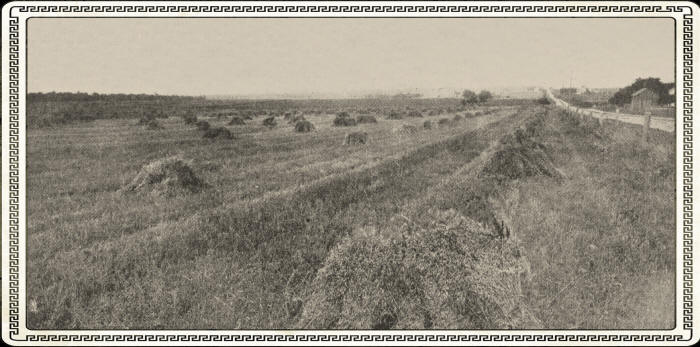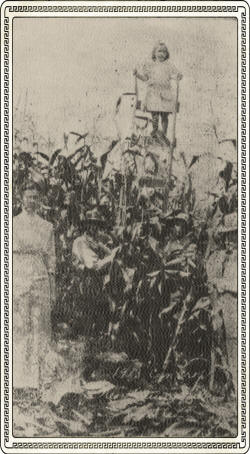AGRICULTURAL OPPORTUNITIES IN CLARK COUNTY, WISCONSIN
By R. A. MOORE, Professor of Agronomy, University of Wisconsin
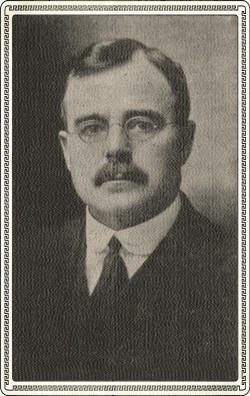
R. A. Moore
ALFALFA IN CLARK COUNTY
By L. F. Graber, dept. of Agronomy, Wis. College of Agriculture
Alfalfa is now a pioneer of Clark County, one of those strong, vigorous, healthy growing pioneers that will help make Clark County one of the leading dairy counties in Wisconsin. Clark County lands which grow clover so abundantly will also grow alfalfa. However, alfalfa growing should not be attempted on newly cleared lands. Such soils should first be planted to cultivated crops or grain and clover for a number of years to get the subdued and in a good condition of tilth. The settler had best depend on clover for hay until his farm his farm has become well established and then he may profitably begin to grow alfalfa for s dairy or beef cattle and sheep. Every farmer in Clark County should make it a practice to mix two pounds of alfalfa seed per acre in with the timothy and clover seed they plant each year. This will produce a sprinkling of alfalfa plants throughout the entire field which will gradually develop the proper in inoculation in the soil so necessary for future crops of alfalfa. With an abundance of lime in soils and proper inoculation and well drained land alfalfa can be grown most any where in Clark County if good judgment and common sense is used in seeding. The College of Agriculture, Madison, Wis., will supply to any farmer in Clark County information in how to test the soil for alfalfa growing as well as how to inoculate with various methods and grow alfalfa to the best advantage. Farmers should avail themselves of every opportunity to secure this information which will prove so important to them in securing good stands this valuable crop.

Second Crop of Clover on Farm of Peter Frost, Withee, Wisconsin
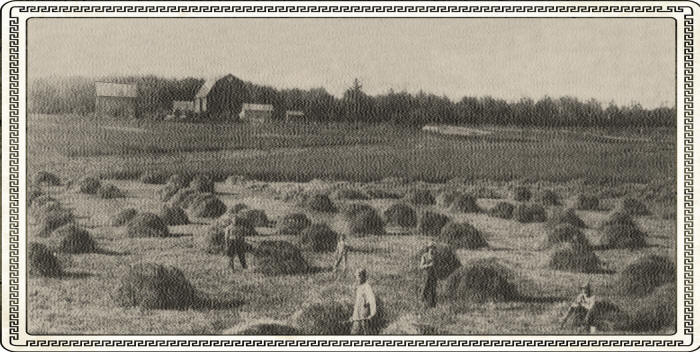
A Clark County Hay Field.
An Oat Field in Clark County, Wisconsin.
Alfalfa should follow some well sated crop such as corn, potatoes or sugar beets or tobacco where the weeds have been gotten well under control. Fall plowing is preferable and if land has an abundance of lime the alfalfa can be seeded with one bushel of barley per acre with hood results provided the seed or the soil has first been properly inoculated. Oats may also he used as a nurse crop, but it should be cut for hay when headed out to give the alfalfa every opportunity to develop. A more certain method of growing alfalfa is to seed the crop alone about the middle or later part of June. The soil is harrowed or disked at frequent intervals to destroy the weed growth. Lime is added if necessary and the seed or soil is carefully inoculated. The alfalfa should he sown at not less than 20 pounds per acre, and with the abundant rains a crop can usually be harvested the last of August. Alfalfa should never be cut later than the first week in September.
|
There is no crop which Clark County farmers can grow that will work so hard for them as will alfalfa. Producing three crops of the most valuable feeding hay in the world for dairy cattle, alfalfa will prove, and is now proving to be a most worthy crop. The beginner if he desires to reap the numerous benefits which come with successful alfalfa growing must study the needs of the crop, which are much more exacting than are those of the native plants such as clover and timothy. If he does not appreciate the importance of inoculation and lime and proper seeding methods he had better not attempt growing alfalfa in Clark County or in any other county in the Middle Western States. Play fair with alfalfa, give it a square deal and you will be well rewarded for your efforts. Before you plant it find out all you can about alfalfa. There is a state alfalfa growers association known as the Wisconsin Alfalfa Order, with headquarters at Madison, Wis. whose membership co-operates in experimental tests on alfalfa for information summarizing the experiences of thousands of alfalfa growers in Wisconsin. Alfalfa is becoming of increasing importance to the dairy farmers of Wisconsin. It has helped to make Wisconsin the leading dairy state in the Union. It has furnished an abundance of the most nutritious hay to feed the dairy cattle which are more numerous in Wisconsin than any other state. It is one of the important feeds that has been the basis of the fact that Wisconsin produces more cheese (one half the total supply of the U. S.) and more butter, has more cheese factories (one half of all the cheese factories in the U. S. are located in Wisconsin) and creameries than any other state in the Union. Clark County offers excellent opportunities to the home seeker and is ideally located in a state surrounded by the worlds greatest markets for farm products such as Duluth, Superior, St. Paul, Minneapolis, Chicago, and Milwaukee and numerous lake ports to the east and north. Wisconsin is the home of the dairy cow, of diversified crops, of alfalfa, clover, corn, and the silo, the land of fertile soils which are kept fertile. |
|
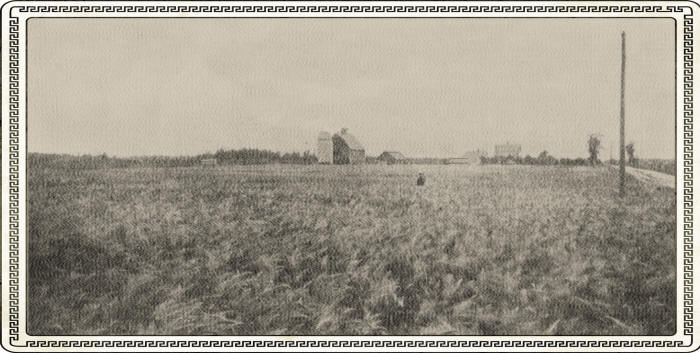
Barley Field of William Haas, Town of Withee.
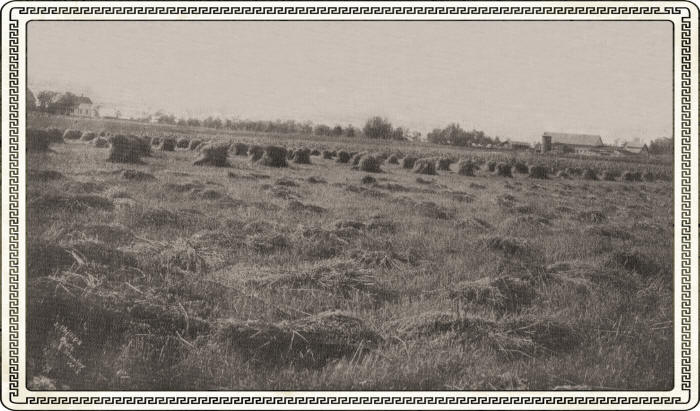
Harvest Field in "The Heart of Wisconsin."
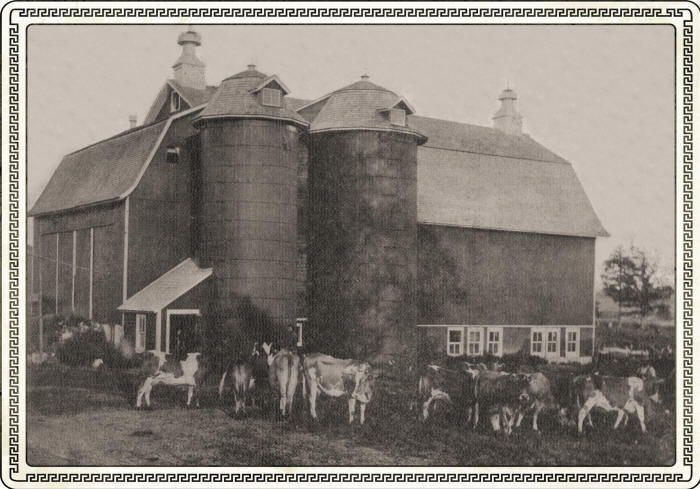
Herd of Pure Bred Guernseys and Model Barn on the W. Scott Davis Farm, Granton.
CATTLE, CORN AND CLOVER
Bring in the Cheese and Creamery Checks in Clark County
Nothing is so dry and uninteresting reading as statistics and the reader would be wearied by mere figures of the wealth and prosperity of Clark County, The Heart of Wisconsin. But figures are necessary in order to give the stranger a basis for forming a true opinion of this garden spot.
It is to the gentle cow that Clark county owes its greatness. From the time when the last of the drives of pine down Black River and its tributaries sounded the knell of the good old logging days, until the present day when assessor reports a total value of all taxable property in the county at thirty three and a third million dollars, it has been the hearty Holstein and the gracious Guernsey with occasional placid Jerseys and other breeds, which has developed the wilderness into a garden spot. The wonderful growth of grasses and clover; the bountiful supply of good, pure, clear water, the unusually healthful climate, invigorating and pleasant winter and summer, makes Clark County the natural center for profitable dairying.
From the official reports of the county clerk given under oath to the county board, there are about 4,500 farms in the county, which has a population of 35,000 people. There are over 600 silos and that number is increasing at the rate of about 100 a year. There are 76 cheese factories and 27 creameries, and over 4000 patrons contribute their product to these institutions resulting in the manufacture of 2,455,922 pounds of butter and 7,111,147 pounds of cheese last year. These patrons received in creamery and cheese factory checks the sum of $1,768,941.
The report states further that there are 31,958 milk cows in the county, representing a value of $1,062,960; that there are 28,162 other cattle -and 13,736 horses, 4,184 sheep and lambs and 10,708 swine over 4 months old.
FRUIT RAISING IN CLARK COUNTY
BY FREDERICK CRANEFIELD, SECRETARY STATE HORTICULTURAL SOCIETY
The State Horticultural Society is engaged in promoting fruit growing in Wisconsin and for that purpose has established eleven so-called Trial Orchards or experiment stations of three to ten acres each. These orchards are for the purpose of testing varieties and testing soils and climate conditions.
While none of these orchards is in Clark County, one has been maintained near Wausau on the east and one has recently been established in Chippewa county on the west.
We also had an orchard for several years in Taylor county, near Medford, and one in Barron county. You will see therefore that even if we have missed your county we have located all around you where conditions are similar to yours.
From my experience in these adjoining counties and from my car window knowledge of Clark County I have no hesitation in saying that: A farmer anywhere in Clark county may without difficulty raise all the fruit needed for home use; that certain portions of Clark County seem well adapted for apple raising on a commercial or market scale. The high, rather rolling clay lands In the vicinity of Neillsville appeal to me very much. I feel certain that the standard Wisconsin apples, such as Duchess, Wealthy, Fameuse McIntosh, Dudley, McMahan and other fall varieties could be grown there successfully and profitably. So far as the home orchard Is concerned anyone anywhere In Clark County may have all the fruit he needs of the kinds commonly grown in Wisconsin.
Some months ago the editor of a paper in a county adjoining yours asked me to outline the fruit situation in Northern Wisconsin and my letter to him seems to fit so closely your attention that I submit it herewith:
There are two classes of farmers to be considered: The ones located near a city of some size or at least having good shipping facilities, to some good market, and the man out in the brush.
The first named class can often raise fruit or vegetables as a side line, but such growers are not apt to meet with much success unless a number of them unite in selling. The lone fruit grower Is absolutely at the mercy of the retailer or the commission man, as the case may be. Co-operation partly solves this problem. I am not much inclined to favor fruit growing for market by farmers in Northern Wisconsin outside of the Bayfield peninsula and Door county where the business is organized, unless the conditions are extra favorable and unless a considerable number in one locality are engaged in the business and organized for the purpose of selling.
The settler, the farmer large or small, who is hewing a home out of the brush and stumps in Northern Wisconsin Is the one who needs help and for him we are prepared to do our utmost. Each and everyone of these pioneers should be doing something toward establishing both an orchard and a small fruit garden.
The Northland of Wisconsin is the land of berries and bush fruits. Here strawberries, raspberries, currants and blackberries grow and bear as nowhere else in the state.
There are two ways for the Northern Wisconsin farmer to start, the theoretical and the practical. Theoretically he should plant an orchard, trees 20 to 25 feet apart, cultivate it thoroughly without intercropping until mid July and then sow a cover crop of oats or vetch. He should proceed in much the same way with the strawberries and bush fruits. Unfortunately he cannot spare all his land and get no returns from it for two or three years.
Suppose we try another plan. Buy a dozen trees, apple, plum and crab and set them about 24 feet apart near the house. Use the space between the rows for potatoes, beans or if must be for grains. If a little judgment is used to avoid over-cropping and a reasonable amount of care in the use of team and tool to avoid injury to the trees the orchard may be cropped for ten years without material damage to the trees and for the first five years without material loss of land.
Fifty strawberry plants will set two rows each 50 feet. These may be planted between the tree rows for the first crop if no other space can he secured. One dozen raspberry plants, six red and six black will be sufficient for a start. Suckers and offsets from these will furnish all the stock needed for enlarging the plantation the second and succeeding years. Three currant and two gooseberry bushes will be enough for a start. The bush fruits may be planted along the outside of the clearing nearest the house if necessary and will do very well there. If grass creeps in mulch heavily with manure in June of July. In this way a good start us made without great expense. This entire bill of stock should cost no more than five dollars. It will be a good substantial start and in fact ao additional stock need be bought for several years if the trees live. But If this seems too much cut it down just one half all along the line and there will be a very respective showing. Here follows an outline toning what to buy, how to buy and how to plant.
WHAT TO BUY
2 crabs, 1 Whitney and 1 Hyslop,2 plum, 1 Se Soto and 1 Surprise
8 apple, 2 Duchess, two Patten Greening, 2 Wealthy. 2 Malinda, all two year old trees.
50 strawberry, 25 Dunlap, 25 Warfield, 6 raspberry (red) Cuthbert or Marlboro, 6 blackcaps, Greg or Kansas, 3 Perfection currant, 2 Downing gooseberry.
HOW TO BUY
(1.) If a nursery agent calls show him your list and ask him to give you the lowest cash price on whole or half of the lot f. o. b. his shipping point without any premium or guarantee nonsense attached. If it is over five dollars let him go.
(2) Send your list to a reliable Wisconsin nursery and ask for prices.
HOW TO PLANT
Plant the trees early, just as early as the ground can be worked In the spring. No fall planting. The fruit trees ought to be planted about 20 feet both ways. Trim the roots a little before planting and trim the tops after planting. Cut off two- thirds of the tops. Failure to cut back the tops immediately after planting is the commonest cause of trees dying.
Set strawberry plants two feet apart in the row and the rows four feet apart. Dont cover the crown or growing center in planting nor leave roots sticking out. Plant berry bushes at least 4 feet apart. Keep out grass and weeds, keep the soil stirred, grow a crop between the trees and vegetation between the berries and bushes also If so desired, have faith and above all ASK QUESTIONS. The State Horticultural Society answers questions free of charge.
FACTS ABOUT CLARK CO.
Climateagreeable and healthful. Average temperature is but five degrees lower than that of central Illinois and Iowafrom 10 to 20 degrees above zero in the winter months and from 60 to 70 degrees in the summer months; over 110 growing days between frost and frost. The mercury sometimes drops to 20 or even 30 degrees below zero but this is for only a day or two at a time and is unusual. The high altitude and dry air contribute greatly to the comfort of living in central Wisconsin.
Average rainfall of 40 to 41 inches, evenly distributed during the growing season. Long droughts are unknown.
Water a good supply of pure clear water can be readily obtainedusually at a depth of from 20 to 50 feet from the surface. Black River and numerous tributary streams drain the county.
The people are thoroughly cosmopolitan; all good Americans hard-working, honest, friendly, enterprising and intelligent. The German-Americans probably predominate among the foreign born population, but there are many Scandinavians, Bohemians, Polish and people of other nationalities.
There is a fine system of country schools and city graded and high schools.
Population 35,000
Assessed valuation (31 towns) $28,978,840.00
Number of farms ..4,500
Number of silos 600
Number of creameries ..27
Number of Cheese Factories 76
Number of patrons contributory ...4,275
Number of cows contributory ...32,260
Number of pounds of milk received. 150,547,380
Amount received by farmers from Creameries
and cheese factories per year ....$2,000,000
Value of much cows .$1,200,000
Value of other cattle ..$500,000
Value of horses .$1,200,000
Value of sheep ..$15,000
Value of swine ..$100,000
Farm Products / Av. yield per acre / Total yield
Wheat 20.5 bu. ..10,000 bu.
Corn ...43.1 400,000
Oats ...47.2 1,500,000
Barley 39.6 100,000
Rye 20.1 40,000
Potatoes .151.5 ..300.000
Hay 2.1 tons .90,000 tons
Related Links
FBI File - Cattle Poisoning by Alien Enemy
********
